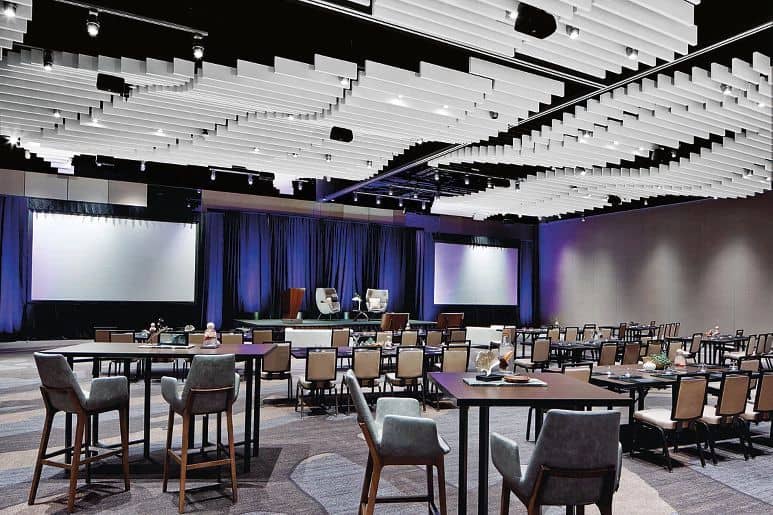
When your roof is someone’s floor it is almost impossible to have a quiet night. However, there are things that can be done to improve the soundproofing of your ceiling. Some of these ways are simple while others require a little bit more effort. However, it is possible to soundproof your ceilings and we would like to go over some of those possibilities.
Soundproofing is relatively simple. It is stopping the sound from going through point A to point B. If you are living in a situation where people are above you, insulating your ceiling can be beneficial to you both.
Two Types of Noise
There are two different types of noise, these are impact noise and airborne noise. Impact noise occurs when something impacts the floor above you. Dropping things, for example, is a perfect example of impact noise. It is the noise that happens from the floor being struck by something.
Airborne noise is noise in the air. This can be things such as children playing, baby crying, barking dog or people yelling. This is a little hard to tune out with ceiling insulation, however, it will certainly help it. Well, that is unless it is coming through the heat vents, then there is really little you can do about this type of noise. So, before you invest in soundproofing be sure that you are soundproofing the proper area. Large rooms can have their own issues, be sure to read more on How can I soundproof a large room.
Different Elements of Soundproofing
There are different ways of blocking sound and soundproofing. Let us go over them and inform you of what they are and what they do.
- Damping
- Decoupling
- Absorption
- Mass
Damping
Damping is done by using damping compounds. This has a unique ability to convert the sound waves to heat and thus stopping the sound in its tracks.
Decoupling
Decoupling is literally separating the two. This is not always possible but it is rather effective.
Absorption

Just as it sounds, it is material that absorbs sound waves. This material can be put into the ceiling to help stop the sound from coming through. For best results, you should keep the material relatively uncompressed for the best results. The material is made to absorb sound and help soundproof the area.
All of the techniques work, but some work better than others. And, certainly if you combine the techniques you can get even better results. Nobody said you couldn’t use more than one soundproofing concept to help soundproof your ceiling.
If you live in a noisy home, it is time to figure out the best way to soundproof. This is not only done in the ceiling but there are other places that the noise can travel. Poor windows, for example, can allow the outdoor noise in with ease. And, the walls are another place that over time the insulation can become less effective. So, keep in mind that you might soundproof your ceiling only to find that you need to soundproof more of your home or business.
Mass
The weight of something is an effective noise blocker too. The materials used for construction will help with this, both on the floors from above and the ceilings below. Using materials that are heavier in weight will be harder for the vibrations of sound to permeate.
Types of Ceilings
Types of Ceilings have a part of the noise as well as determine what is the best way to go about soundproofing your ceiling.
Drywall Ceilings
Drywall is a material called gypsum that is encased in paper. It is different than other boards and offers unique properties. It is a very common material used in the building process.
Suspended or drop ceilings
If you are wanting a more aesthetic look then drop ceilings are just the thing. However, you need to have headroom to allow for a drop ceiling. Not everyone’s walls are tall enough to incorporate a drop ceiling. The minimum is 2″. Drop ceilings are effective in helping with the sound but drywall tends to be a bit more effective unless you get soundproofing in the panels themselves. These panels are made to help block out the sound that is in the drop ceiling such as ductwork and pipes. Check out what is an acoustic panel ceiling here now.
There are several ways to soundproof the ceiling but first, you needed to determine what the material is that you will be working with. If it is drywall try to double up the drywall and make it two layers. Drywall also comes in soundproof drywall sheets. However, this kind of drywall is about four times the price of regular drywall and for that reason, it is not super highly used. But, it is very effective in keeping the noises out. Putting sound-absorbent fiberglass between the two floors helps as well. Do not pack the insulation for the best results.
Double up the Drywall
You could also double up on the drywall and add two layers. Drayway ceilings are pretty labor-intensive and more costly than a drop ceiling. However, if you are working with a drywall ceiling, doubling up on the material will help with soundproofing.
There are many other ways such as floating ceiling joists which can only be used if you don’t have any ductwork in the ceiling. This is where to extend the new joists 2″ below the original. This is a part of decoupling, which breaks up the sound travel.
Other options are working on the floor above you. Putting down an underlayment that will keep the floor from being so loud in the first place. Or even a rug would help absorb some of the noise if the floor is a hard surface. There is also acoustic underlayment that can be used to help with sound absorption as well.
Mass loaded Vinyl
Mass loaded vinyl is material that absorbs sound. It can be used in conjunction with the double up drywall. By sandwiching the mass loaded vinyl between the two sheets of drywall you get another level of soundproofing.
Some things to keep in mind when looking at the options are the building codes for your area. Simple things such as rugs and soundproofing dampening run liners wouldn’t come into play with the building codes. But, when you are starting to get into the structure of the building this is very important to keep in mind.



